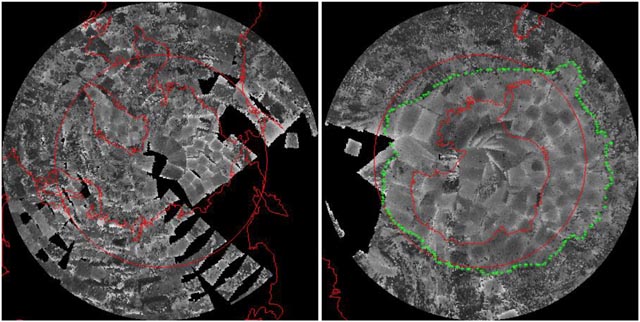|
Rolling back the clockNSIDC scientists reconstruct sea ice extent around polar regions from 1960s satellite imageryPosted May 3, 2013
The National Snow and Ice Data Center (NSIDC)
NSIDC is releasing new sea ice data from the 1960s after scanning nearly 40,000 images and stitching them together to create composite images of the Arctic and Antarctic that were shot by the Nimbus
The nearly half-century old imagery was part of an archive of 50 cardboard boxes stored at the National Climate Data Center
NSIDC is partly funded by the National Science Foundation
Since 1979, satellites have provided a continuous, nearly complete record of Earth’s sea ice, according to NASA

Photo Courtesy: NSIDC
NSIDC acquire dozens of canisters of 35-millimeter film that contained images of the 1964 Arctic sea ice minimum and the Antarctic maximum.
“There were no fancy satellite sensors in 1964,” noted NSIDC data specialist Garrett Campbell in the online news story. “Scientists strapped a video camera to the Nimbus 1 satellite, sent it into orbit, and hoped for the best.”
As it circled the globe between Aug. 28, 1964 and Sept. 23, 1964, Nimbus 1 transmitted still shots of the Earth to a television monitor, which researchers photographed. After using the stills for weather forecasting research, scientists archived them in a secure storage facility.
In 2009, NSIDC technical services manager Dave Gallaher “stumbled” on a NASA conference poster about the recovery of the film, and realized that it would have captured images of the Arctic sea ice minimum and the Antarctic maximum in 1964.
“We really wanted these,” he said.
The timing of when the imagery was shot is particularly fortuitous, capturing the minimum extent of Arctic sea ice and the maximum extent of Antarctic sea ice. Most scientists believe the modern-day decline of sea ice in the Northern Hemisphere is due to human-induced climate change.
Meanwhile, the trend in the Antarctic shows a slight increase in sea ice extent, possibly due to atmospheric changes in the Southern Hemisphere.
“This film contains basically the earliest satellite data we have of Arctic and Antarctic sea ice extent,” said NSIDC scientist Walt Meier
Campbell, who spent the past two years examining shots from the film rolls, said the images would have been too overwhelming for researchers to process in the 1960s.
“We didn’t have the computing power to handle all those images at that time,” he explained. “In 1964, researchers would have had to develop every single frame as a photograph and lay it out on the floor of a large room.”
Fifty years later, the computer power was more than up for the task.
Campbell worked with two undergraduate students to scan close to 40,000 frames, made sure the images had the right latitude and longitude, and stitched the photos together on his computer.
Photo Credit: Kelly Speelman/Antarctic Photo Library
Weddell seals lie near a crack in the sea ice in McMurdo Sound, Antarctica.
With those images, Campbell produced the first satellite maps of the sea ice edge in 1964 and an estimate of September sea ice extent for both the Arctic and the Antarctic. According to the data, September Antarctic sea ice extent measured about 19.7 million square kilometers.
“That’s higher than any year observed from 1972 to 2012,” Meier noted.
Figuring out the sea ice extent for the Arctic was more challenging, according to the story. It was harder for the team to distinguish the ice edge along the coasts from snow or glacier-covered islands in the Canadian Archipelago. Also, there were not many images of Alaska and eastern Siberia to work from, so Campbell relied on old Russian and Alaskan ice charts.
His analysis yielded a September 1964 Arctic sea ice extent of 6.9 million square kilometers.
“The 1964 estimate is reasonably consistent with 1979 to 2000 conditions,” Meier said. “It suggests that September extent in the Arctic may have been generally stable through the 1960s and the early 1970s.”
NSIDC will make these images, as well as high-resolution infrared data from the Nimbus 1 satellite, available to researchers beginning this month. The team has also acquired satellite imagery from Nimbus 2 and 3, and other satellites operating in the late 1960s and early 1970s.
The result, hopefully, is a longer record of sea ice that Meier said would “put the dramatic decline of Arctic summer sea ice extent in a longer-term context” and prove useful to other scientists studying today’s changing climate.
|



For USAP Participants |
For The Public |
For Researchers and EducatorsContact UsU.S. National Science FoundationOffice of Polar Programs Geosciences Directorate 2415 Eisenhower Avenue, Suite W7100 Alexandria, VA 22314 Sign up for the NSF Office of Polar Programs newsletter and events. Feedback Form |


